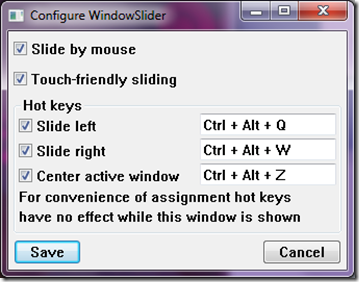[wpfilebase tag=file path='01/WindowSlider.zip']
Generally, people need multiple windows to be open at the time of work. However, they may find it distracting and confusing to see multiple windows lying one on top of the other. Situations may also surface requirements to arrange windows over the visible portion of the screen.
Though many applications allow real estate management of the screen, they do not provide much of an area to work with. Further, it requires a lot of manual work to minimize and maximize a single window while others sit in the background.
Windows Slider comes in as a solution to all these issues by allowing you to extend your screen infinitely towards the left and right.
What is Windows Slider?
Windows Slider is a desktop management application which extends the desktop width infinitely on both sides. It lets you open any number of windows and applications on the desktop and lets you slide the screen to access them without even worrying about minimizing and maximizing. Follow thelink to download and install Windows Slider.
How to Configure?
Once you have installed Windows Slider, you will find it residing in the system tray. Right click on the icon to launch its menu.
Select the Configure option to launch the configuration window. There are basically five checkable options. These help you select the method you want to use for sliding your screen. While the first options are for the mouse interface, the other three are sets of hot keys. The second one comes disabled by default.
How to Slide Desktop?
The easiest option is the “Slide by Mouse” option. To slide the screen left and right, move the mouse pointer to the center of the edge respectively. If you have the “Touch-friendly Sliding” option checked, you will find a scroll appearing at the bottom of the screen. To use this, you must hold the right click and drag/scroll in the desired direction.
For keyboard users, they have a set of hot keys:
- Ctrl-Alt-Q for left and Ctrl-Alt-W for right
- Ctrl-Alt-Z for centering on active window
- Alt-Tab for switching windows
The hot keys combinations are editable by launching the configuration window.
Conclusion
One reason that made me use this application was that I no longer had to worry about minimizing and maximizing windows. I could open as many windows as I liked on my desktop without operlapping. Switching over windows was just a scroll away.
Give it a try and let us know what you think in the comments.
SOURCE | LINK (Lostintechnology.com)
| LANGUAGE | ENGLISH |







